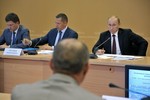- published: 25 Jul 2013
- views: 14
SANTIAGO DE COMPOSTELA, Spain (AP) — A Spanish train that hurtled off the rails and smashed into a security wall as it rounded a bend was going so fast that carriages tumbled off the tracks like dominos, according to eyewitness accounts and video footage obtained Thursday. The official death toll from Wednesday night's crash near this Christian festival city in northwest Spain rose to 78 in Spain's deadliest wreck in four decades. Hospital officials said 141 people were injured, and 36 remained in critical condition Thursday, among them four children. Prime Minister Mariano Rajoy, who was born in Santiago de Compostela, toured the crash scene alongside rescue workers and went to a nearby hospital to visit some of the wounded and their families. ''For a native of Santiago, like me, this is the saddest day,'' Rajoy said. He said judicial authorities and the Public Works Ministry had launched parallel investigations into what caused the crash. Eyewitness accounts backed by security-camera footage of the moment of disaster suggested that the eight-carriage train carrying 218 passengers was going too fast as it tried to turn left underneath a road bridge. The speed limit on that section of track is 80 kilometers (50 miles) per hour, Spanish officials said. The footage, which the Spanish railway authority Adif said probably came from one of its cameras, shows the train carriages start to buckle soon into the turn, with the first and second passenger carriages leaving the tracks first. The engine itself quickly follows, violently tipping on to its right side as it crashes into a concrete security wall and bulldozes its way along the ground. In the background, all the rear carriages can be seen starting to decouple and come off the tracks. The picture goes blank as the engine appears to crash directly into the camera. ''I saw the train coming out of the bend at great speed and then there was a big noise,'' one eyewitness, Consuelo Domingues, told The Associated Press. ''... Then everybody tried to get out of the train.'' Santiago officials, who had been preparing for the city's annual Catholic festival Thursday, canceled it and took control of the main sports stadium to use as a makeshift morgue. There, relatives of many of the dead could be seen sobbing and embracing each other. Maria Pardo Rios, spokeswoman for the Galicia region's main court, said 73 people died at the scene, four others after they were taken to hospitals. The Interior Ministry later confirmed a 78th death. A regional Galicia health official, Rocio Mosquera, told reporters Thursday afternoon that 95 people remained hospitalized, among them 36 in critical condition, including four children. The Interior Ministry, responsible for law and order, ruled out terrorism as a cause. It was Spain's deadliest train accident since 1972, when a train collided with a bus in southwest Spain, killing 86 people and injuring 112. ''July 24 will no longer be the eve of a day of celebration but rather one commemorating one of the saddest days in the history of Galicia,'' said Alberto Nunez Feijoo, regional president of Galicia. Santiago de Compostela is its capital. The accident created a scene that was ''Dante-esque,'' Feijoo said. He declared seven days of mourning for the victims. Rescue workers spent the night searching through smashed carriages alongside the tracks. As dawn broke, cranes brought to the scene were used to lift the carriages off the tracks. Rescue workers collected passengers' scattered luggage and loaded it into a truck next to the tracks. Rescuers described a scene of horror immediately after the crash. Smoke billowed from at least one carriage that had caught fire, while another had been torn into two parts. Residents of the residential neighborhood closest to the rail line struggled to help victims out of the toppled cars. Some passengers were pulled out of broken windows. Television images showed one man atop a carriage lying on its side, using a pickaxe to try to smash through a window. Other rescuers used rocks to try to free survivors from the fiery wreckage. Nearby, rescue workers lined up bodies covered in blankets alongside the tracks. State-owned train operator Renfe said it couldn't confirm how many staff were on board the train. It said the crash happened at 8.41 p.m. (1841 GMT) about 2.5 miles (4 kilometers) south of Santiago de Compostela. Spanish media said the train had two drivers aboard and both survived. Renfe said it and Adif, another state-owned company that manages tracks, signals and other railway infrastructure, were cooperating with a judge appointed to investigate the accident.

































































































































































